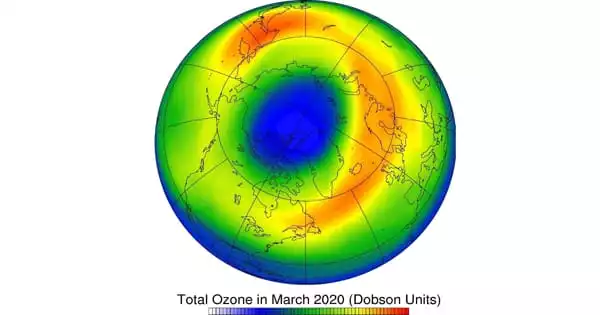According to a new study, exceptionally cold winter temperatures high in the atmosphere over the Arctic are becoming increasingly common and extreme as a result of climate patterns connected with global warming. The study also demonstrates that the severe low temperatures are generating reactions among chemicals that humans blasted into the air decades ago, resulting in increased ozone losses.
There is a race going on in the atmosphere above the Arctic, and the ozone layer, which protects the Earth from harmful ultraviolet (UV) radiation, may lose if greenhouse gas emissions are not decreased soon enough.
A new study led by an international team of scientists, including University of Maryland Professor Ross Salawitch, finds that exceptionally cold winter temperatures high in the atmosphere above the Arctic are becoming more common and intense as a result of climate patterns related with global warming. The study also demonstrates that the severe low temperatures are generating reactions among chemicals that humans blasted into the air decades ago, resulting in increased ozone losses.
The new findings throw into doubt the widely held belief that after the 2010 global ban on the manufacture of ozone-depleting compounds known as chlorofluorocarbons (CFCs) and halons, ozone loss will come to a halt in a matter of decades.
The work was published in the journal Nature Communications by UMD, the Alfred Wegener Institute’s Helmholtz Centre for Polar and Marine Research, and the Finnish Meteorological Institute.
We’re in a race between the slow and steady decline in CFCs, which takes 50 to 100 years to disappear, and climate change, which is causing polar vortex temperature extremes to become colder at a rapid pace.
Professor Ross Salawitch
“We’re in a race between the slow and steady decline in CFCs, which takes 50 to 100 years to disappear, and climate change, which is causing polar vortex temperature extremes to become colder at a rapid pace,” said Ross Salawitch, a professor in the UMD Departments of Atmospheric and Oceanic Science, Chemistry and Biochemistry, and the Earth System Science Interdisciplinary Center. “CFCs deplete the ozone layer due to the increased cold temperatures. As a result, despite the fact that these molecules are gradually depleting, Arctic ozone depletion is increasing as the climate changes.”
According to the study’s new data, the Arctic polar vortex temperatures and ozone losses were the lowest on record in 2020, breaking the previous record established nine years before in 2011. The polar vortex is a largely self-contained low-pressure system that arises in the stratosphere above the Arctic every autumn at an altitude of roughly 12 to 50 kilometers (7.5 to 31 miles) and lasts for different lengths throughout the winter and spring. Because the polar vortex’s pattern of warm and cold winter temperatures is relatively erratic, not every winter is exceptionally frigid.
However, the researchers are concerned about the trend toward more frequent and intense low temperatures in the polar vortex, because those conditions increase cloud formation, which causes ozone loss in the polar stratosphere.

The breakdown of CFCs, halons, and other ozone-depleting compounds produces the majority of the chlorine and a large amount of the bromine in the stratosphere. Normally, chlorine is non-reactive within the Arctic polar vortex, but clouds offer the perfect conditions for chlorine to change form and react with bromine and sunlight to destroy ozone.
Despite significant reductions in commercial production of CFCs and halons since the Montreal Protocol in 1987 and the subsequent global prohibition in 2010, these long-lasting chemicals are still ubiquitous in the atmosphere. According to the World Meteorological Organization, human-produced atmospheric chlorine and bromine are not anticipated to decrease below 50% of their maximum levels until the end of the century.
The researchers predicted ozone loss out to the year 2100 based on the long-term temperature trend in the polar vortex and the forecasted drop in chlorine and bromine chemicals to evaluate what this condition means for the future. They based their predictions on the output of the Intergovernmental Panel on Climate Change’s 53 top climate models.
“With the exception of one climate model,” Salawitch said, “all of the climate models we looked at show that particularly cold winters in the polar vortex will increase colder over time. And the higher the level of greenhouse gas emissions, the sharper the trend, implying greater ozone depletion.”
The researchers confirmed that the Arctic is already witnessing a strong trend toward lower stratospheric temperatures and accompanying increases in ozone losses by combining these projections with assessments of meteorological data from the previous 56 years. Furthermore, their findings show that these trends are occurring at a rate consistent with the most recent climate models.
“We’ve been saying for a number of years that a train is coming,” Salawitch said, referring to research papers he published in 2004 and 2006 that showed harsh winters in the Arctic were increasing colder. “The train has now passed us by, with record ozone depletion in 2011 and now in 2020. So, this paper is truly a wake-up call that something crucial for ozone is happening in the atmosphere, and it appears that greenhouse gases are driving it.”
Salawitch and his colleagues do not yet completely understand how rising greenhouse gas emissions and the resulting changes in global climate are driving the polar vortex’s unusually cold winters in the stratospheric layer. However, some of the fundamental mechanisms are known. Global warming happens in part because greenhouse gases trap heat closer to the Earth’s surface, allowing cooling of the high stratosphere, which contains the ozone layer. Warming at the surface alters prevailing wind patterns, and the researchers hypothesize that these changes result in lower temperatures in the polar vortex.
The researchers also point out that methane, a more powerful greenhouse gas than carbon dioxide, has been rapidly increasing in the lower atmosphere in recent years. As this gas rises into the stratosphere, it raises humidity, creating circumstances that favor ozone-depleting chemical processes in the Arctic.
Because ozone filters a large portion of the sun’s potentially hazardous UV radiation, a depleted ozone layer above the Arctic can result in increased UV radiation reaching the Earth’s surface over Europe, North America, and Asia when the polar vortex dives south.
According to the experts, there is yet hope for mitigating future ozone depletion. Their research suggests that significant reductions in greenhouse gas emissions over the next few decades could result in a continuous fall in conditions that support high ozone losses in the Arctic stratosphere.
















